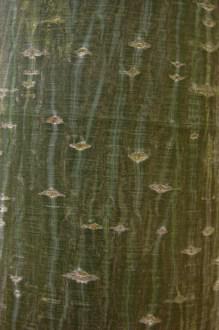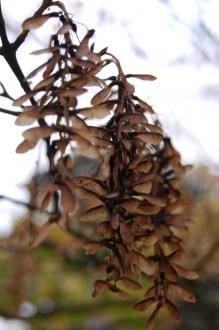
Acer capillipes bark (12/11/2011, Kew, London)
Position: Full Sun to Partial Shade
Flowering period: Late Spring
Soil: Moist, well-drained
Eventual Height: 12m
Eventual Spread: 8m
Hardiness: USDA Zones 5a – 9a
Family:Sapindaceae
Acer capillipes is a small deciduous tree with a spreading crown and arching branches. The mid green leaves of the plant are 10 -15 centimeters long and 6 – 12 centimeters broad, with three or five lobes. These basal lobes are quiet small and have a serrated margin, conspicuous veining and a reddish 4 – 8 centimeter petiole. The leaves become red and yellow in autumn. The bark of the tree is smooth, olive green with regular narrow vertical white stripes and small horizontal brownish lenticels, it retains this pattern even on very old trees. The trunk of this tree may achieve a diameter of 70cm although more usually they are smaller with multiple stems and slender branches. The flowers are small, greenish yellow and are produced on 8 – 10 centimeter drooping racemes. These racemes are initially first then they become pendulous. The fruit, a samara nutlet, is 5 millimeters long with a 2 centimeter long wing.

Acer capillipes seed (12/11/2011, Kew, London)
Acer capillipes, commonly known as the Snake Bark Maple, Red Snake Bark Maple or Kyushu Maple, is native to the mountainous regions in Japan on central and southern Honshu, Kyushu and Shikoku Islands, usually growing alongside mountain streams. Acer cappillipes was introduced into the Arnold Arboretum in 1892 as a many stemmed tree like shrub.
The etymology of the binomial name Acer is derived from the classical Latin name for the Maple. Capillipes is derived from the Latin capillus for thread or hair, this refers to the fine branches of this tree.
The landscape architect may find Acer capillipes useful as a small ornamental specimen tree in a parkland scheme or domestic garden. It has an architectural habit, interesting bark and attractive red autumn foliage.

Acer capillipes (12/11/2011, Kew, London)
A. capillipes has been awarded the prestigious Royal Horticultural Societies annual Award of Garden Merit in 1993.
A. capillipes prefers fertile, moist but well-drained, neutral to acidic soils.
Maintenance: This plant requires little maintenance.

